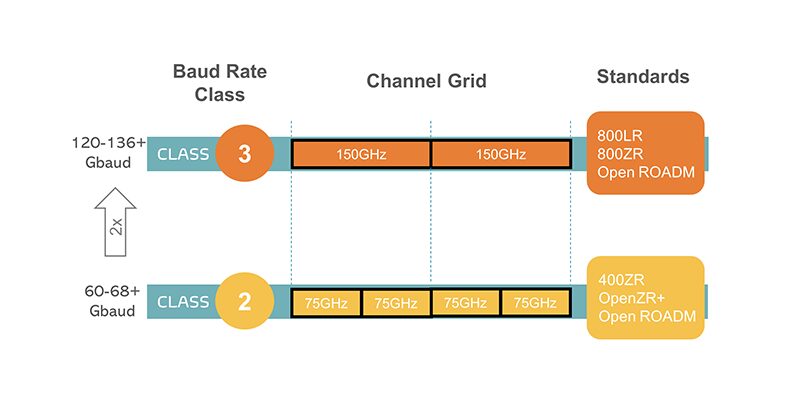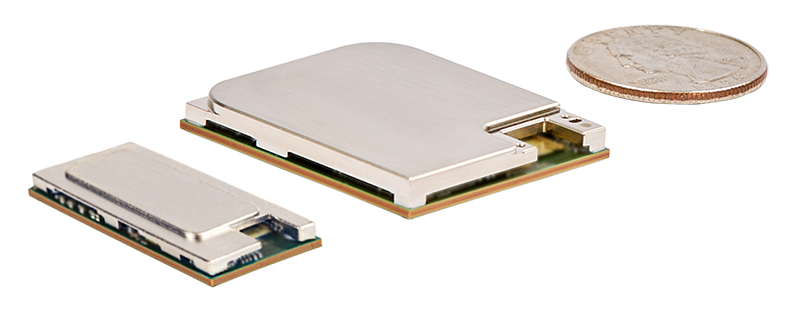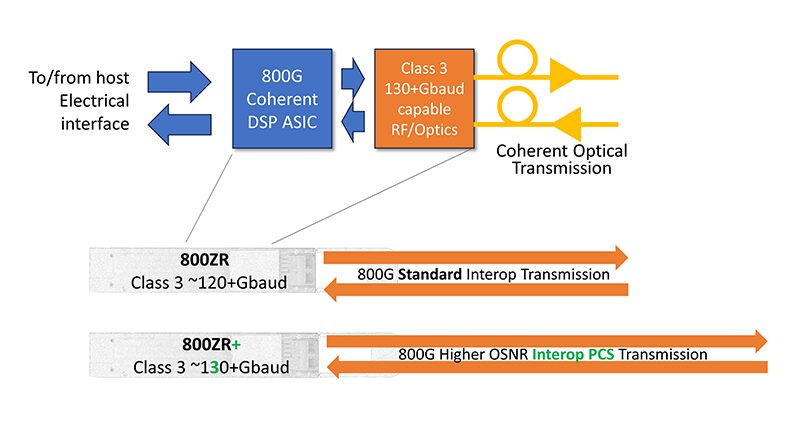In this blog, we outline key requirements for the upcoming generation of 800G MSA pluggable modules, intended to coincide with the availability of switch/router platforms utilizing next generation ASICs being introduced with 800G I/O port speeds. Similar to the OIF 400ZR MSA pluggables, we anticipate hyperscalers to drive volume deployments in support of data center interconnect (DCI) upgrades to take advantage of these next-generation switch/routers.
Multiple standardization bodies, including the OIF, Open ROADM, and the IEEE, are working in parallel to standardize 800G optical transmission and 800 Gigabit Ethernet (GbE) protocols, helping to foster economies of scale. In parallel, module vendors are introducing the required technologies to enable low power 120+Gbaud solutions that would fit into small form-factor modules such as QSFP-DD and OSFP.
Higher Baud Rates, Standardization, and Higher Levels of Integration
With the 400G MSA pluggable generation, the industry via OIF converged onto Class 2 ~60Gbaud rate range and 4 bits/symbol 16QAM modulation order to enable 400G transmission within a 75GHz optical spectrum (Figure 1). Open ROADM requirements, targeting service providers, also included the same modulation order and similar baud rates, as well as additional transmission flexibility specifying more modulation modes, such as 2 bits/symbol QPSK to enable longer reaches at 200G.

At 800G, the industry has converged to a 2x scaling of baud rate resulting in Class 3 ~120 Gbaud rates, as shown in Figure 1. Channel spacing requirements double to 150GHz for 800G, providing a straightforward network scaling supporting similar reaches to 400G Class 2 devices. As with 400G, this convergence is expected to drive economies of scale of the technology supporting this baud rate class.
To realize the modulation capability for Class 3 120+Gbaud operation, advancements in both high-speed optical modulation and supporting components as well as high-speed 112G-per-electrical-lane capabilities were needed to enable 800G MSA pluggables in compact form factors. These optical and electrical high-speed capabilities have already been proven with the introduction of Acacia’s performance-optimized Coherent Interconnect Module (CIM) 8 module which utilizes silicon photonics, high speed ADC/DACs, RF components, and Acacia’s 3D Siliconization for Class 3 120+Gbaud transmission. The high-level of integration from 3D Siliconization allows this high baud rate technology to fit into QSFP-DD and OSFP pluggable form-factors, all while maintaining high signal integrity and low power consumption.

Key Features Needed for 800G MSA Pluggable Modules
To meet customer needs and drive future adoption, 800G coherent MSA pluggables should have a number of key features and capabilities related to optical transmission, client traffic, low power consumption, and interoperable module management.

Optical Transmission Features
OIF 800ZR and high-performance interoperable PCS modes. OIF is defining an interoperable standard performance 800ZR variant addressing coherent line interfaces for amplified, single span, DWDM links over 80km using Class 3 optics operating at ~4 bits/symbol (equivalent to 16QAM) modulation. For a higher performance 800G solution, Open ROADM is defining enhanced performance modes that include an interoperable probability constellation shaping (PCS) implementation utilizing both Ethernet and OTN framing.
Multi-haul capable. In current Class 2 ~60Gbaud MSA pluggable solution designs capable of adjusting the modulation mode, a long reach 200G capability is available by setting the modulation order to QPSK (2 bits/symbol) rather than 16QAM (4 bits/symbol) used for 400G transmission. This capability was standardized in Open ROADM and adopted by OpenZR+. Class 3 ~120Gbaud solutions can be used for 800G metro/regional reaches, and for multiple different standard and proprietary modes at 400G and 600G to address a wide range of network requirements.
High transmit optical power capability. Like high-Tx (>0dBm) optical power capabilities introduced in Acacia’s Bright 400ZR+ QSFP-DD modules, 800G coherent MSA modules will require optical amplification to operate over traditional brownfield networks with ROADM network elements. Internal optical amplification is a key feature variant for this generation to support these types of networks.
Client Traffic Features
800GbE client traffic support. A key client traffic protocol to be supported in 800G generation coherent MSA pluggables is 800GbE. IEEE P802.3dfTM aims to define the requirements for native Ethernet traffic at 800G data rates. To support native 800G Ethernet traffic from switch/router I/O ports, 800G generation coherent MSA pluggables are required to support this protocol.
Multiplexing lower speed 100/200/400GbE electrical client traffic. It is expected that when 800G coherent MSA pluggables are introduced, 100GbE, 200GbE, and 400GbE will continue to be widely deployed client traffic speeds. Therefore, 800G pluggables need to support the ability to multiplex these lower speed protocols into 800G transmission, with requirements being established by the standardization groups. For networks utilizing OTN, support for FlexO at 800G could be possible.
Power Consumption and Management
Low power consumption. As with other MSA pluggable solutions, optimizing for low-power operation is a priority. The leveraging of Moore’s law with decreasing CMOS node sizes along with increased ASIC functionality has been a reason for the success of coherent pluggables—providing high-capacity links in a small form-factor. Power-optimized designs continue to be a priority for the new generation of Class 3 baud rate coherent MSA pluggables, not only for compliance in 800G slots, but also for backwards compatibility into lower-rate 400G legacy ports which have more restrictive power consumption requirements.
Content Management Interoperability Services (CMIS) compliance. In addition to industry standardization efforts at the optical transmission and client traffic levels, there has been a concerted effort to ensure multi-vendor interoperability of the module management interface through CMIS, defined in OIF. This ensures a common and predictable management signaling interface between the module and the host switch/router from one module vendor to another. CMIS compliance, a key requirement for 400G MSA modules, is going to extend to 800G as well.
Interoperable PCS Modes
Taking a page from the performance-optimized coherent playbook, 800G MSA pluggable solutions are expected to introduce interoperable PCS optical transmission. PCS shapes the optical transmission using an algorithm that weights the constellation to utilize the inner points more than the outer points, resulting in improved OSNR performance with a minimal increase in overhead. While previous implementations of PCS have always been proprietary, several key DSP vendors have collaborated over the last 12 months to enable the industry’s first introduction of interoperable PCS for 800G MSA pluggables.

Driven by Open ROADM, the 800G interoperable PCS implementation provides a power-optimized method to boost the performance beyond 800ZR, similar to how oFEC boosted the performance beyond 400ZR in OpenZR+ modules. This additional performance allows 800G implementations to achieve similar reaches as 400G implementations based on 16QAM transmission. This Open ROADM interoperable PCS mode operates in the 130+Gbaud range, which is slightly higher than the 800ZR mode, but can still enable transmission in 150GHz channels. With interoperable PCS, network operators can benefit from a greater range of network implementations from the initial 800G MSA pluggable offerings compared to the initial 400G point-to-point offerings of the previous generation.
Following the Right Path to 800G Pluggables
In summary, operators are looking for the following key functional requirements to transition to 800G coherent MSA pluggables.
- Support for OIF 800ZR and high-performance interoperable PCS modes
- Multi-haul capable
- High Tx optical power option
- 800GbE client traffic support
- Multiplexing lower speed 100/200/400GbE electrical client traffic
- Low power consumption
- CMIS compliance
This solution can plug directly into switch/router ports to further drive adoption of IP-over-DWDM router-based optical network architectures. The first 800G pluggable deployments are expected in 2024.


